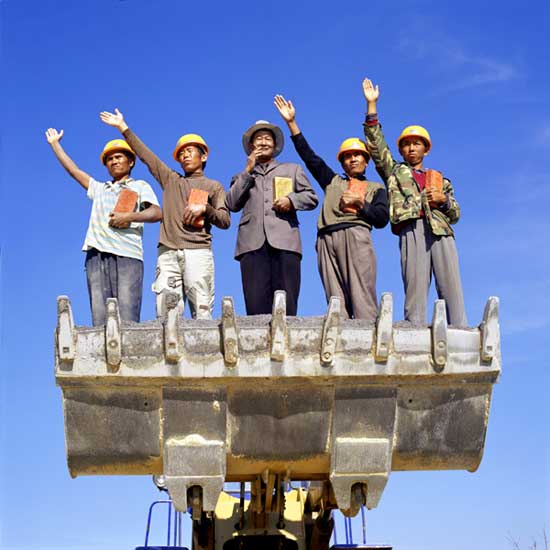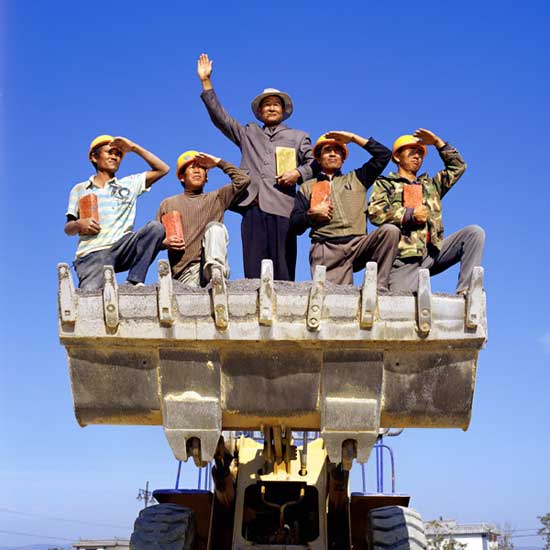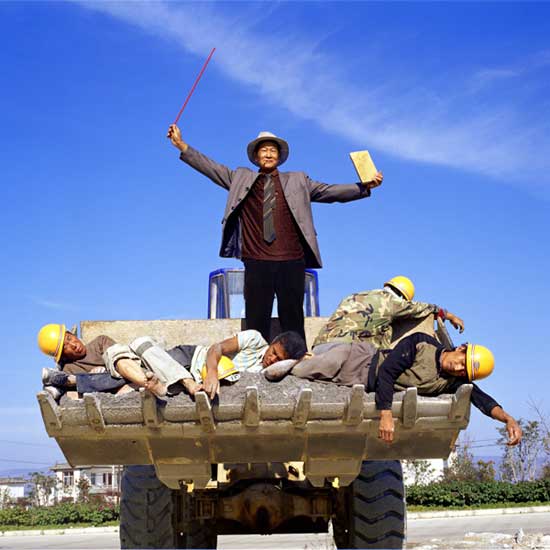ORPHANS OF PROGRESS
WORKERS AND POLITICAL DISCOURSE IN POST-SOCIALIST CHINA
by William Hurst
performance photography by Han Bing
From soon after his founding the Republic until the end of his tumultuous tenure as President of Indonesia, Sukarno was widely known as the dalang, or puppet master, of Indonesian politics. “Bung Karno” skillfully played off militarists, Islamists, and communists in a manner reminiscent of the puppeteer’s balancing of competing forces to maintain order in the universe of the Mahabarata and Ramayana adaptations that are the staple of Javanese shadow-puppet theater. But the machinations of the puppeteer or politician are more than mere manipulations; true masters deeply animate the characters whose strings they pull. Sometimes, as in the case of the dalang’s puppets and arguably also that of post-independence Indonesia’s political factions, all the figures appearing onstage were actually wrought by the master in hidden labor before the performance.

Having come to power in one of the world’s most agrarian and least industrial societies, the Chinese Communist Party (CCP) first had to call a proletariat into being before it could become its vanguard. This was accomplished through nationalization of private industry where it existed and rapid construction of large-scale state-owned industries elsewhere. The transformative effect on China’s political discourse, economy, and society can hardly be overstated. Still, this creation and ascendance of a new socialist working class was further celebrated, especially in the peak campaign periods of the Great Leap Forward (1958-62) and the decade encompassing the Great Proletarian Cultural Revolution (1966-76), taking on the status of a national myth.
Chinese workers, therefore, became accustomed to hero status and enjoyed near-constant political adulation. Even when their livelihoods lagged and their material subsistence sometimes even came under threat, they were assured of being hailed for their spirit of shared sacrifice and rewarded with new benefits when conditions improved. All of this fell to pieces, however, with the CCP’s move to cut loose roughly half of the workforce in state and collective firms – more than 60 million people – between 1993 and 2008.
These workers were not let go all at once or in a uniform pattern across all of China. Rather, 40 percent of the formal urban labor force was slowly bled out of state firms over a 15-year period through mechanisms that varied sharply across regions and sectors. As one state enterprise manager in Chongqing explained, “the whole phenomenon of SOE lay-offs is like boiling a fish. If you drop it directly into a pot of boiling water, it will fight to the death and try to escape. But if you put it in a pot of cold water and gradually turn up the heat, the fish just sits there quietly. It has no feeling and then it just dies. This is what the state has been doing to China’s great proletariat for the past ten years” (Hurst 2009a: 3). By the middle of this decade, one of the largest social shifts since 1949 had taken place, casting tens of millions adrift without work unit membership in Chinese society.

Youth Offered up to Capital: Theater of Modernization II (2007)
The policy of mass lay-offs sparked bitter resentment, but also a sense of profound anomie and despair, among the workers affected. Most responses by workers to their new status as outcasts from a reconstituted polity and at the margins of China’s transforming economy have therefore been forlorn, quiet, and private. The once exquisite puppets, who for years performed brilliant feats upon the stage, have lost their puppeteer; few are able to mount much resistance.
In some cases, however, workers have taken their grievances public, reshaping public narratives of working class activism, socialist idealism, and the new ideology of market success. Specifically, workers’ public manifestations have pushed China’s evolving political discourse in three directions. First, withering critiques of market-socialism and nostalgic calls to restore key parts of the Maoist order have breathed life into leftist resentment of economic reform. Second, attempts to assert new contractual legal rights as employees have helped redefine what it means to be a worker and pressed the state and Party to take more seriously everyday dimensions of a “rule by law”. Third and finally, by their very fragmentation and disarticulation, workers have cemented the demise of class struggle in Chinese political thought and debate.
Some workers, particularly those older than 45 and those in Northeastern China, have given voice to profound nostalgia for the Maoist era (Hurst 2009b; Lee 2000). These claims have been general, restorative, and moral-economic in nature. As one laid-off Beijing chemical worker, who’d found new work as a taxi driver, complained, “When I was young, I was a Red Guard, on of the vanguard of the proletariat. Now, I am the modern Xiangzi.1 I go here and there around Beijing and can never earn enough to live in peace. The taxi company boss is just like the boss in the story as well; by day he drinks my sweat, at night he sucks my blood….No one cares about us workers anymore. Things were much better when Chairman Mao was alive and I was in the factory” (Hurst 2008: 76-77). Some workers were even more explicit, such as those who staged a protest in Benxi, in Liaoning Province, who paraded around the main square with a portrait of Mao Zedong, framed by the Cultural Revolution slogans: Read Chairman Mao’s Books; Listen to Chairman Mao’s Words; and Conduct Business According to Chairman Mao’s Method (Hurst 2009b: 127).
More in line with what Ching Kwan Lee has observed in much of her research (Lee 2007), many laid-off workers have also taken on a leading role in the articulation of new frameworks of contractual and legalistic social and economic relations. Specifically, many workers in Shanghai and other large coastal cities have made explicit and frequent use of contracts and legal agreements in pressing their claims. Almost none of these workers reference Maoist slogans or ways of thinking. In fact, some interviewees spoke of a need to de-program or re-program workers to think in market frames (Hurst 2009a: 103). All of this facilitated the rise of a new consciousness of labor and work relations – one that both affirms China’s still ongoing marketization and presents a novel basis for mobilization in Chinese society.
Finally, workers’ expression of their interest as individuals, or even as members of social groups other than the “socialist proletariat”, has perhaps done more to cement the passing of class struggle from Chinese political discourse than anything else. The disarticulation of class, therefore, is in some ways a unifying narrative in itself (Hudson, Hurst, and Sorace 2010, forthcoming). Even though workers are less and less enmeshed in the broader subject of a working class, their fragmentation has produced differentiation that can be liberating, as well as atomizing, for the individual.
Do such influences leave workers more powerful, or at least more autonomous, than they were as puppets of the CCP in the pre-reform era? Perhaps. But gains in autonomy have been tempered by losses in effectiveness and coherence. As analysts and leaders of labor politics the world over have long known, workers’ political clout is substantially increased by the degree to which otherwise disparate subgroups can advance their interests as members of a working class. Thus, general, or even sector-based, unions are usually much more efficacious than craft unions; and broadly “labor-based” political parties win power more often than their more narrowly constituted counterparts.
Although broad labor coalitions and class mobilization depend crucially on shared worldviews and ways of life, these clearly no longer hold for the Chinese working class in general – or even for state sector workers in particular. In this sense, Chinese workers are certainly less empowered than they were a decade ago or, indeed, even under the tight political and social control of the Maoist period. In another sense, however, workers are now much less constrained by their class identity and consciousness. Advocacy of individual or cross-cutting group interests is no longer out of bounds. The fading of an old discourse of class struggle, in other words, has also helped loosen the chains of class-based thought.

Youth Offered up to Capital: Theater of Modernization III (2007)
Chinese workers today, then, are not merely the lifeless disused puppets of a dalang, now putting on a different show or otherwise moving on to other pursuits. But they have not yet found their individual roles and voices in the next act of China’s great political drama. It still remains to be seen whether the working class will wither away in its current state or reconstitute itself powerfully and with greatly enhanced autonomy. The discourse of what it means to be a worker and even of how individuals relate to social groupings or the collective body politic is still very much up for grabs. It will be up to enterprising Chinese workers to seize mastery over this aspect of their destiny.
REFERENCES
Hudson, James, William Hurst, and Christian Sorace (2010, forthcoming). “Workers in Post-Socialist China: Shattered Rice Bowls, Fragmented Subjectivities” in Yin-hwa Chu ed. Chinese Capitalisms New York: Palgrave-MacMillan.
Hurst, William (2008). “Mass Frames and Worker Protest” in Kevin J. O’Brien ed. Popular Protest in China Cambridge MA: Harvard University Press, pp.71-87.
Hurst, William (2009a). The Chinese Worker after Socialism Cambridge: Cambridge University Press.
Hurst, William (2009b). “The Power of the Past: Nostalgia and Popular Discontent in Contemporary China” in Thomas Gold, William Hurst, Jaeyoun Won, and Li Qiang eds. Laid-off Workers in a Workers’ State: Unemployment with Chinese Characteristics New York: Palgrave-MacMillan, pp.115-132.
Lee, Ching Kwan (2000). “The ‘Revenge of History’: Collective Memories and Labor Protests in Northeast China” Ethnography 1(2): 217-237.
Lee, Ching Kwan (2007). Against the Law: Labor Protests in China’s Rustbelt and Sunbelt Berkeley: University of California Press.
1 This is a reference to the title character in Lao She’s famous 1936 novel, Luotuo Xiangzi (Camel Xiangzi), which chronicles the inhuman conditions and horrific exploitation faced by a rickshaw puller in Beijing during the early 1920s.
Return to table of contents here.
